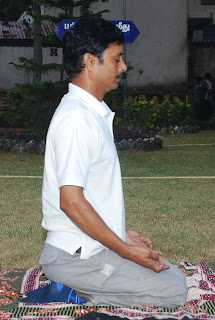HEALTH ‘N’ YOGA
(Natural Solution for Healthy Life)
DIABETES
It is not an exaggeration to say that more than 10% of people suffer from diabetes in our country. There is no age restriction to the disease from a week baby to 60 year old to affect the disease.
What is Diabetes?
Diabetes is a disorder of metabolism, the way our bodies use digested food for growth and energy. Most of the food we eat is broken down into glucose. After digestion, the glucose mix with blood stream, where it is used by cells for growth and energy. For glucose to get into cells, insulin must be present. Insulin is hormone produced by the Pancreas, a large gland behind the stomach.
When we eat, the pancreas automatically produces the right quantity of INSULIN to move glucose from blood into our cells. Generally, people with diabetes, however, the pancreas either produces little or no insulin or the cells do not respond appropriately to the insulin that is produced. Glucose builds up in the blood, overflows into urine, and passes out of the body in the urine. Thus, the body loses its main sources of fuel even though the blood contains large quantities of glucose.
SYMPTOMS OF DIABETES:
- Frequent urination
- Too much Thirst
- Too much hunger
- Loss of weight
- Loss of vision
- Tiredness
- Delayed healing of wounds or cuts
- Numbness in the hands and legs
- Weakness
- itching sensation
- Skin diseases
- Burning feeling while passing urine
- Too much white discharge in woman.
HOW MUCH SUGAR THERE SHOULD BE IN BLOOD ?
- Fasting blood sugar - early morning in empty stomach is 80 mg to 115mg.
- Post paradial blood sugar - Two hours after food is below 180 is normal.
If the blood sugar is above 200mg. along with other symptoms the person is said to suffer diabetes.
REASON FOR DIABETES:
• Hereditary,
• Over Eating ,
• Over Weight,
• Lack of Exercise,
• Mental stress and strain,
• Due to Some Drugs,
• Because of Age,
• Because of Contagious diseases.
COMPLICATIONS :
The Diabetes will attract a variety of diseases. Diabetes can affect any part of the body like Eyes, Kidneys, Blood vessels, Nervous and Heart. Once those parts are affected, it is really difficult to get back to normal condition. Besides, the patient will subject himself to much agony. So, it is better to keep oneself away from those complications by practicing Yoga, good food habits, regular exercise and proper drugs, before it becomes too late.
WHAT ARE THE REMEDIAL MEASURES TO PROTECT FROM DIABETES
YOGA : Ancient Indian medical system, Ayurveda, the philosophy of which also encompasses Yoga, considers diabetes as a psychosomatic disorder with causative factors being sedentary habits, physical, emotional and mental stress.
Yoga postures were developed thousands of years ago in India and were designed to assist man to counteract the effect of living a life far different from the one we were designed to live by nature.
All Asanas and Pranayama techniques meant to treat diabetes, are known to influence in the following ways:
1. Direct influence on Pancreatic secretion by rejuvenation of the pancreatic cells, through alternate abdominal contraction and relaxation.
2. Reduction in blood sugar due to muscular exercise involved in Asanas.
3. Yoga changes one's attitude towards life by developing mental relaxation and balance.
4. Reducing the activity of autonomic nervous system.
5. Reducing the weight of the individual.
6. Providing will power to follow the strict diet regimen required.
7. Consumption of daily doses of medicines can be drastically reduced and eventually stopped by the continuous practice of Yoga. This is scientifically proved fact.
PRANAYAMA:
• Kapalpathi Pranayam
• Bhahaya Pranayam
• Agnisar Pranayam
YOGA ASANAS:
• Suryanamaskarm
• Mandukasana
• Pavana Mukthsana
• Divya Chakrasana
• Markatasana
• Brisk Walking 1/2 to 1 hr
TAKE FOLLOWING FOOD:
Amla, Garlic, Pumpkin, Bitter gourd, Onion, Tomato, Papaya, Snake gourd, ladies fingers. Drumstick fresh and cooked vegetable leaves. Take Menthe leaves and menthe powder regularly.
FOOD SHOULD AVOID:
- Sugar, Honey, Jaggery, glucose and all sweets,
- Cashew nuts, almond, Pista, Dry grapes,
- Cool drinks, alcohol, Horlicks, Boost, Complan,
- Tender coconut water and tender coconut,
- Banana, mango, Jack fruit, custard apple,Sapota,
- Maida, cakes, glucose biscuits,
- Potatoes, and all root Vegetables,
- Ghee, butter, Cheese, coconut oil, Palm oil, Gingelly Oil etc.,
LOW BLOOD SUGAR:
Low Blood Sugar means not having enough sugar or glucose in the blood. Low blood sugar is also called hypoglycemia, insulin shock, or insulin reaction. Glucose is needed by the body cells. A normal blood sugar level is 80 - 115mg in Fasting. When the blood sugar is below 70 is called low sugar. The normal blood sugar level less than 180 to 200mg % after two hours of food.


